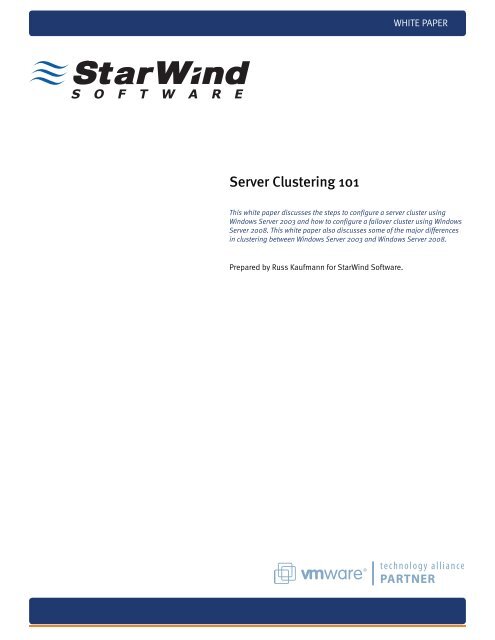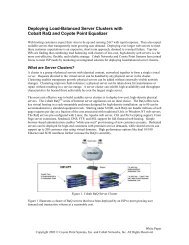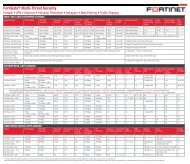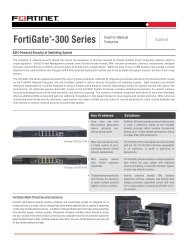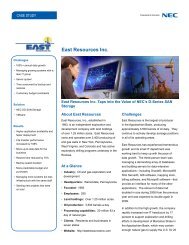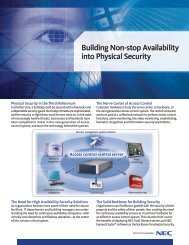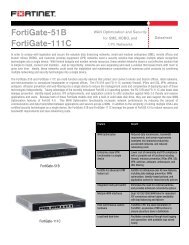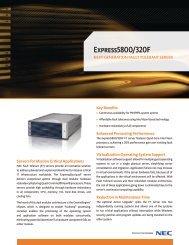Microsoft Server Clustering 101 Guide - Foreseeson
Microsoft Server Clustering 101 Guide - Foreseeson
Microsoft Server Clustering 101 Guide - Foreseeson
Create successful ePaper yourself
Turn your PDF publications into a flip-book with our unique Google optimized e-Paper software.
<strong>Server</strong> <strong>Clustering</strong> <strong>101</strong><br />
This white paper discusses the steps to configure a server cluster using<br />
Windows <strong>Server</strong> 2003 and how to configure a failover cluster using Windows<br />
<strong>Server</strong> 2008. This white paper also discusses some of the major differences<br />
in clustering between Windows <strong>Server</strong> 2003 and Windows <strong>Server</strong> 2008.<br />
Prepared by Russ Kaufmann for StarWind Software.<br />
WHITE PAPER
BaSiC QueStionS<br />
To learn about clustering, it is a good idea to start with some<br />
basic questions and answers. Setting up clusters really is not<br />
as difficult as most administrators believe.<br />
What is <strong>Clustering</strong>?<br />
A cluster is a group of independent computers working together<br />
as a single system to ensure that mission-critical applications<br />
and resources are as highly-available as possible. The<br />
group of computers is managed as a single system, it shares a<br />
common namespace, and it is specifically designed to tolerate<br />
component failures. A cluster supports the addition or removal<br />
of components in a way that’s transparent to users.<br />
The general concept in clustering is that there are nodes,<br />
which are computers that are members of the cluster that are<br />
either active or passive. Active nodes are running an application<br />
or service while passive nodes are in a standby state<br />
communicating with the active nodes so they can identify<br />
when there is a failure. In the event of a failure, the passive<br />
node then becomes active and starts running the service or<br />
application.<br />
One way to explain how a cluster works is to define reliability<br />
and availability then use the terms to help explain the concept<br />
of clustering.<br />
Reliability – All computer components, such as a hard drive,<br />
are rated using the meantime before failure (MTBF). Components<br />
fail, and it is very true of components with moving parts<br />
like hard drives and fans in a computer. They will fail; it is just<br />
a matter of when. Based on the MTBF numbers, it is possible<br />
to compute the probability of a failure within a certain time<br />
frame.<br />
availability - Using the example of a hard disk, which has a<br />
certain MTBF associated with it, we can also define availability.<br />
In most organizations, we don’t care so much about failed<br />
hardware devices. Users of information technology care only<br />
that they can access the service or application that they need<br />
to perform their jobs. However, since we know that hardware<br />
devices will fail, administrators need to protect against the<br />
loss of services and applications needed to keep the business<br />
running. When it comes to hard drives, administrators are<br />
able to build redundant disk sets, or redundant arrays of independent<br />
(sometimes described as inexpensive) disks (RAID),<br />
that will tolerate the failure of an individual component, but<br />
still provide the storage needed by the computer to provide<br />
access to the files or applications on the drive. Availability is<br />
[2] www.starwindsoftware.com<br />
often measured using mean time to recovery and<br />
uptime percentages.<br />
<strong>Clustering</strong>, at the most basic, is combining unreliable devices<br />
so that a failure will not result in a long outage and lost availability.<br />
In the case of a cluster, the redundancy is at the server<br />
computer level, however, the redundancy is configured per<br />
service or application. For example the following figure shows<br />
two nodes that connect to a shared storage device, which is<br />
usually a SAN.<br />
An application or service can run on either node so that<br />
multiple applications or services can be spread out among<br />
all the nodes of a cluster making multiple nodes active in the<br />
cluster. The failure of an application or service on a node does<br />
not mean that all other applications or services also on the<br />
node will also fail. For example, a print server can run on the<br />
same node as a DHCP server, and if the DHCP service fails, it<br />
may not cause the print service to also fail if the problem is<br />
isolated to the DHCP server. In the event of a hardware failure,<br />
all applications and services will failover to another node.<br />
In the figure, there are two computers that are also known as<br />
nodes. The nodes, combined, make up the cluster. Each of the<br />
nodes has at least two network adapters. One of the network<br />
adapters is used to connect each node to the network. The<br />
second network adapter is used to connect the nodes to each<br />
other via a private network, also called a heartbeat network.<br />
The private network is used by the cluster service so the nodes<br />
can talk to each other and verify that each other are up and<br />
running.<br />
The process of verification uses two processes called the<br />
looksalive resource check and the isalive resource check. If<br />
the resources in the cluster fail to respond to the resource<br />
checks after the appropriate amount of time, the passive node
will assume that the active node has failed and will start up<br />
the service or application that is running on the cluster in<br />
the virtual server. Some nodes will also have a third network<br />
adapter dedicated to the iSCSI network to access the iSCSI<br />
SAN. If an iSCSI SAN is used, each node will connect to the<br />
SAN through a dedicated network adapter to a private network<br />
that the iSCSI SAN also uses.<br />
Each of the nodes is also connected to the shared storage<br />
media. In fact, the storage is not shared, but it is accessible to<br />
each of the nodes. Only the active node accesses the storage,<br />
and the passive node is locked out of the storage by the<br />
cluster service. In the figure here, there are three Logical Unit<br />
Numbers, or LUNs, that are being provided by the SAN. The<br />
nodes will connect to the SAN using fiber channel or iSCSI.<br />
What is a Virtual serVer?<br />
One way to define a virtual server is to take a basic application<br />
or service and break it down into its components. For example,<br />
a file server needs several resources in order to exist. A<br />
file server needs:<br />
• A computer to connect to the network<br />
• A TCP/IP address to identify the server and make it accessible<br />
to other computers running TCP/IP<br />
• A name to make it easy to identify the computer<br />
• A disk to store data such as the files in a file server<br />
• A service such as the file server service that enables the<br />
server to share files out to other computers<br />
In the case of a virtual server, it needs a TCP/IP address, a<br />
name, a disk, and a service or application just like a real<br />
server. In the case of a cluster, the virtual server uses resources,<br />
too. In clustering, the resources have formal names.<br />
For example, there is a Network Name which is the name of<br />
the virtual server, an IP Address which is the TCP/IP address of<br />
the virtual server, a Physical Disk which resides on the shared<br />
storage and holds the data for the service or application, and<br />
a Service or Application that is installed on each node in the<br />
cluster but only runs on the active node. These resources are<br />
grouped together into virtual servers. Users will connect to the<br />
virtual server name for the resources they need.<br />
In a cluster, there may be multiple virtual servers. The key<br />
to clustering is that if an active node fails, the passive node<br />
takes control of the IP Address, Network Name, Physical Disk,<br />
and the Service or Application and starts running the service<br />
or application. The active node runs the service or application,<br />
and the same service or application does not run on the pas-<br />
[3] www.starwindsoftware.com<br />
sive nodes. In the event of a failure, the service or application<br />
stops functioning on the active node and the passive node detects<br />
the failure and starts running the service or application.<br />
Users still connect to the same name that they used before<br />
and are able to continue running the application.<br />
Why Would i use <strong>Clustering</strong>?<br />
There are two major benefits of running services and applications<br />
on a cluster. The first reason is to increase availability of<br />
a service or application, and the second reason is to reduce<br />
the downtime caused by maintenance.<br />
Increasing uptime and availability of a service or application<br />
should always be a goal of an information technology department.<br />
By having the cluster service monitoring the service<br />
or application, any failures can be quickly identified and the<br />
service or application can be moved to another node in the<br />
cluster within moments. In many cases, a failing service or<br />
application can be restarted on a surviving node in the cluster<br />
so quickly that nobody will even notice that it failed. Workers<br />
can continue accessing the service or application and will not<br />
have to call the help desk to notify the information technology<br />
department that it failed. Not only will they not have to make<br />
those phone calls, they will be able to do their jobs without<br />
having to wait for the service or application to be reviewed by<br />
the information technology department and then wait for it to<br />
be fixed. In other words, it leads to increased productivity.<br />
Software and hardware maintenance time can be reduced<br />
considerably in a cluster. Patching and upgrading services and<br />
applications on a cluster is much easier in most cases. In a<br />
cluster, software and hardware maintenance can be done after<br />
being tested in a test environment. Maintenance can be done<br />
on a passive node without impacting the services and applications<br />
running on the cluster. The active node can continue to<br />
run during the maintenance of the passive node.<br />
If maintenance is also required on the active node, it is a simple<br />
matter to schedule the work for slow times and move the<br />
service or application to the passive node making it the active<br />
node. If, for some reason, the service or application fails, it is<br />
a simple matter to move it back to its original node, and then<br />
troubleshoot any problems that may have come up without<br />
having the clustered service or application unavailable.<br />
If there are no problems with the maintenance work, then<br />
the other node can be upgraded/fixed as well. This process<br />
also works with simple operating system patches and service<br />
packs. The down time associated with simple maintenance
is reduced considerably and the risk associated with such<br />
changes is also reduced.<br />
PReReQuiSiteS<br />
For a cluster to be properly supported, and functional, there<br />
are several prerequisites that are required as well as a few that<br />
are recommended to improve performance and stability. This<br />
section will cover the steps that should be performed before<br />
configuring the cluster.<br />
softWare<br />
The proper operating system is the first requirement. Windows<br />
<strong>Server</strong> 2003 requires either:<br />
• Windows <strong>Server</strong> 2003 Enterprise Edition<br />
• Windows <strong>Server</strong> 2003 Enterprise Edition R2<br />
• Windows <strong>Server</strong> 2003 Datacenter Edition<br />
• Windows <strong>Server</strong> 2003 Datacenter Edition R2<br />
Windows <strong>Server</strong> 2008 requires:<br />
• Windows <strong>Server</strong> 2008 Enterprise Edition<br />
• Windows <strong>Server</strong> 2008 Datacenter Edition<br />
Both Windows <strong>Server</strong> 2003 and Windows <strong>Server</strong> 2008 support<br />
32-bit and 64-bit versions of the above operating systems,<br />
however, mixing 32-bit and 64-bit in the same cluster is not<br />
supported, and mixing the operating systems between Windows<br />
<strong>Server</strong> 2003 and Windows <strong>Server</strong> 2008 is not supported,<br />
either.<br />
Windows <strong>Server</strong> 2008 failover clusters have an additional<br />
prerequisite that includes installing Windows Powershell. This<br />
prerequisite can be installed through the GUI or through the<br />
command line. For command line, run <strong>Server</strong>ManagerCMD -i<br />
PowerShell from a command prompt.<br />
Cluster aWare serViCes and appliCations<br />
Many services and applications are cluster aware. What makes<br />
a service or application cluster aware is that it has been written<br />
to use the APIs provided by the cluster service. Cluster<br />
aware services and applications are used to leverage the cluster<br />
service and to provide high availability to a service or application.<br />
Cluster aware versions of applications often require<br />
special editions of the software. Some well known and often<br />
clustered services and applications include the following:<br />
• File Services<br />
• Print Ser vices<br />
• DHCP – Dynamic Host Configuration Protocol<br />
[4] www.starwindsoftware.com<br />
• WINS – Windows Internet Naming Service<br />
• DFS – Only standalone DFS can be deployed on a server<br />
cluster, and domain roots for DFS are not supported<br />
• <strong>Microsoft</strong> Exchange<br />
• <strong>Microsoft</strong> SQL<br />
• Lotus Domino<br />
• IBM DB2<br />
• SAP<br />
• PeopleSoft<br />
• JD Edwards<br />
This list is far from being all inclusive. There are many line of<br />
business, internally developed, and third party products on<br />
the market that are cluster aware.<br />
The main value in a cluster aware service or application is that<br />
the cluster service is able to monitor the health of the resources<br />
in the cluster group or virtual server. In the event a resource<br />
fails the health checking by the cluster service, the cluster<br />
service will failover the service or application to another node<br />
in the cluster and start up the service or application within<br />
seconds in many cases and within a couple of minutes in others.<br />
The time required to failover is based on the type and size<br />
of the service or application.<br />
Cluster unaWare serViCes and appliCations<br />
There are many services and applications that are not cluster<br />
aware. These services and applications do not leverage the<br />
functionality of all of the clustering APIs. For example, these<br />
applications do not use a “Looks Alive” and “is Alive” check<br />
for the application. In cluster aware applications, the resource<br />
checks can test and monitor the health of the resources for the<br />
service or application and then cause it to failover in the event<br />
of a problem with the application. This is not possible with a<br />
cluster unaware application.<br />
However, despite not being able to use all of the features of<br />
clustering, cluster unaware applications can be run in clusters<br />
along with other critical resources. In order to use these<br />
cluster unaware applications, we must use generic resources.<br />
While a cluster will not protect the service or application resources,<br />
clustering will protect the service or application from<br />
a complete server node failure. If the node fails, even a cluster<br />
unaware application can be started on a surviving node in the<br />
cluster.<br />
serViCe installation<br />
The cluster service is automatically installed on Windows <strong>Server</strong><br />
2003 Enterprise and Datacenter versions. <strong>Server</strong> clustering
needs to be configured for Windows <strong>Server</strong> 2003, however,<br />
even though it is installed.<br />
In Windows <strong>Server</strong> 2008, the Failover Cluster feature must be<br />
installed on all nodes before they can be added to a cluster.<br />
Adding the Failover Cluster feature is just like adding any other<br />
feature for Windows <strong>Server</strong> 2008. Once the feature is added,<br />
then it can be configured and service and applications can be<br />
added afterwards.<br />
netWork<br />
Each node of the cluster is connected to at least two different<br />
networks for clustering purposes. Each node is connected to<br />
the public network which is where clients can connect to the<br />
cluster nodes and attach to applications and services running<br />
on the cluster as if the virtual servers were normal servers. The<br />
second network is the private network, also referred to as the<br />
heartbeat network.<br />
This network is used to connect all nodes of the cluster together<br />
so they can keep track of the availability of the nodes in<br />
the cluster. It is through this heartbeat network that a passive<br />
server node can detect if the active server node has failed and<br />
then can take action to start the virtual servers on it.<br />
DnS tab – In the “Internet Protocol TCI/IP” properties<br />
and in the advanced properties on the DNS tab, unselect<br />
“Register this connection’s addresses in DNS”<br />
netBioS – In the “Internet Protocol TCI/IP” properties<br />
and in the advanced properties on the WINS tab select<br />
the radio button for “Disable NetBIOS over TCP/IP”<br />
Services – remove the “Client for <strong>Microsoft</strong> Networks”<br />
and the “File and Printer Sharing for <strong>Microsoft</strong> Networks”<br />
on the General tab for the connection properties.<br />
It is possible that other networks also are used for such things<br />
as dedicated backups or for iSCSI connections, but they are<br />
not used for cluster purposes.<br />
Private network Configuration – Proper configuration of the<br />
private network will remove unneeded services and help the<br />
network function in a nice and simple configuration; which is<br />
all that is needed.<br />
The heartbeat network is a private network shared just by the<br />
nodes of a cluster and should not be accessible to any other<br />
systems including other clusters. It is not supposed to be<br />
[5] www.starwindsoftware.com<br />
routable at all. Make sure that you use private IP addresses<br />
per RFC 1918 for your heartbeat network that do not exist anywhere<br />
else in your network.<br />
The recommended ranges, per RFC 1918, include:<br />
• 10.0.0.0 – 10.255.255.255 (10/8)<br />
• 172.16.0.0 – 172.31.255.255 (172.16/12)<br />
• 192.168.0.0 – 192.168.255.255 (192.168/16)<br />
Speed and Duplex - Always configure the network adapters<br />
manually to force the setting for best performance. Leaving the<br />
NIC set to the default of “Auto Detect” can result in improper<br />
configuration settings. If the NIC is 100 MB and Full Duplex<br />
and the switch supports it, then force the setting to 100 Full.<br />
network Priority – A common problem with the configuration<br />
of the network settings is that the network priority is not<br />
configured properly. The priority can be configured for the<br />
networks in the advanced properties for the network connections.<br />
The public network should be first in the binding order<br />
because it is the one that is most used and it is the one that<br />
will have the most impact on user access to the cluster. The<br />
private network is not going to have anywhere near the network<br />
traffic of the public network.<br />
storage<br />
The shared disk environment for clustering is vital to the cluster<br />
working properly. The quorum (known as a witness disk in<br />
Windows <strong>Server</strong> 2008) is maintained on one of these disks<br />
and it should have its own separate disk of at least 512 MB<br />
and formatted using NTFS. All disks presented by the shared<br />
storage environment must have the same drive letter associated<br />
with them on all nodes. So, the quorum must have the<br />
same drive letter on all nodes in the cluster, for example.<br />
Cluster disks<br />
The disks used in clustering should not be confused with the<br />
disks used by the nodes to host the operating system and to<br />
host binaries for clustered applications. It is important to note<br />
that no matter what the source is of the shared disks, they<br />
must be formatted using NTFS and they must be presented<br />
to Windows as basic disks. In many SAN environments, the<br />
control of which servers can access the disks is handled by<br />
the SAN environment. Cluster disks are used by applications<br />
that need a place to store their data such as Exchange <strong>Server</strong><br />
and SQL <strong>Server</strong>.<br />
Shared – The disk environment must be visible and accessible<br />
by all nodes in the cluster. While only one node can access
individual disks at a time, the disks must be able to be transferred<br />
to another node in the event of a failure. While the disks<br />
are not truly shared, they can be mounted and accessed from<br />
the nodes in the cluster.<br />
San – Storage area networks (SANs) typically use storage-specific<br />
network technologies. <strong>Server</strong>s connect to the storage and<br />
access data at the block level usually using a host bus adapter<br />
(HBA). Disks available via the HBA are treated just like disks<br />
attached directly. In other words, SAN disks are accessed using<br />
the same read and write disk processes used for locally attached<br />
disks. SANs can use fiber channel or iSCSI technology.<br />
SANs are the preferred method of providing disks to the cluster<br />
nodes. A SAN is able to provide a large amount of space<br />
and divide it up in several smaller pieces as needed for each<br />
application. For example, two physical disks (and it can be<br />
parts of disks in the SAN in most cases) are combined in a<br />
RAID 1 set to create the Quorum disk, two disks are<br />
combined in a RAID 1 set to create a Log disk, and three disks<br />
are combined in a RAID 5 set to create the Data disk. Each of<br />
these three LUNs are seen by the nodes as physical disks. So,<br />
the nodes see three disks; one intended to be used for the<br />
quorum, one intended to be used for the logs, and one intended<br />
to be used for the data drive. The sizes, number of physical<br />
disks used, and the RAID type can vary for performance<br />
reasons and are also subject the capabilities of the SAN.<br />
naS – Generally, Network Attached Storage (NAS) devices<br />
are not supported for server clustering. Several third parties,<br />
though, create drivers that allow their NAS drives to be used<br />
for clustering, but they are the ones that end up having to provide<br />
support in the event there are any problems. NAS does<br />
not use block level access like a SAN does. However, drivers<br />
can be used to make the file share access used by NAS to<br />
make it look and act like block level access in a SAN.<br />
iSCSi – iSCSI is a newer technology that is supported for server<br />
clustering starting with Windows <strong>Server</strong> 2003 Service Pack 1<br />
and is fully supported for failover clustering in Windows <strong>Server</strong><br />
2008. With iSCSI, a node is able to connect to the shared<br />
storage on the iSCSI server using iSCSI initiators (the client<br />
side) connecting to iSCSI targets (the storage side where a<br />
server runs the target software and exposes the disks) across<br />
standard Ethernet connections. GigE is preferred for higher<br />
performance, and 10GigE is now becoming more available.<br />
<strong>Microsoft</strong> supplies its own iSCSI initiator, and we recommend<br />
using it because they support up to 8 node clusters using their<br />
[6] www.starwindsoftware.com<br />
initiator. <strong>Microsoft</strong>, at this time, does not provide an iSCSI<br />
target except through Windows <strong>Server</strong> Storage Edition that is<br />
only available through original equipment manufacturers. It is<br />
recommended that if iSCSI is being used that a dedicated network<br />
be used for all storage traffic to get the best performance<br />
from the storage device.<br />
In the case of iSCSI, there will be at least three network adapters<br />
for each node; one NIC for the public network, one NIC<br />
for the private (heartbeat) network, and one NIC for the iSCSI<br />
traffic supporting the storage device.<br />
Storage virtualization software that converts industry-standard<br />
servers into iSCSI SANs provides a reliable, flexible and costeffective<br />
shared storage that can be centrally managed. iSCSI<br />
technology is scalable enough to meet the needs of many<br />
large enterprises yet, at the same time, it is also cost-effective<br />
for the SMB market. For example, StarWind Software, provides<br />
enterprise-level features like volume based snapshots, fault<br />
tolerant storage via its network-based RAID1 mirror functionality<br />
and remote, asynchronous replication. This set of features,<br />
combined with the solid foundation of a 4th generation<br />
product, makes StarWind Software an ideal choice for server<br />
applications such as <strong>Microsoft</strong> <strong>Server</strong> <strong>Clustering</strong> and Failover<br />
<strong>Clustering</strong>.<br />
StarWind Software also provides a cost effective platform for<br />
Hyper-V and Live Migration as well as Windows server clustering<br />
for database applications such as <strong>Microsoft</strong> SQL <strong>Server</strong>,<br />
<strong>Microsoft</strong> Exchange and <strong>Microsoft</strong> SharePoint <strong>Server</strong>.<br />
Luns – Logical Unit Numbers are used to identify disk slices<br />
from a storage device that are then presented to client computers.<br />
A LUN is the logical device provided by the storage<br />
device and it is then treated as a physical device by the node<br />
that is allowed to view and connect to the LUN.<br />
Quorum<br />
In Windows <strong>Server</strong> 2003, there are three options for the quorum:<br />
1. Local Quorum – This option is used for creation of a single<br />
node cluster and does not support the addition of other<br />
nodes. A single node cluster is often used in development<br />
and testing environments to make sure that applications<br />
can run on a cluster without any problems.<br />
2. Quorum Disk – In the large majority of Windows <strong>Server</strong><br />
2003 server clusters, a disk is used that resides on the
shared storage environment and it is configured so it is<br />
available to all the nodes in the cluster.<br />
3. Majority Node Set (MNS) – In MNS, quorum information<br />
is stored on the operating system drive of the individual<br />
nodes. MNS can be used in clusters with three or more<br />
nodes so that the cluster will continue to run in the event<br />
of a node failure. Using MNS with two nodes in a cluster<br />
will not provide protection against the failure of a node.<br />
In a two node cluster using MNS, if there is a node failure,<br />
the quorum cannot be established and the cluster service<br />
will fail to start or will fail if it is running before the failure<br />
of a node.<br />
In Windows <strong>Server</strong> 2008, there are four options for the quorum:<br />
1. Node majority – Node majority is very much like MNS in<br />
Windows <strong>Server</strong> 2003. In this option, a vote is given to<br />
each node of the cluster and the cluster will continue to<br />
run so long as there are a majority of nodes up and running.<br />
This option is recommended when there is an odd<br />
number of nodes in the cluster.<br />
2. Nodes and Disk Majority – This is a common configuration<br />
for two node clusters. Each node gets a vote and the<br />
quorum disk (now called a witness disk) also gets a vote.<br />
So long as two of the three are running, the cluster will<br />
continue. In this situation, the cluster can actually lose<br />
the witness disk and still run. This option is recommended<br />
for clusters with an even number of nodes.<br />
3. Node and File Share Majority – This option uses the MNS<br />
model with a file share witness. In this option, each node<br />
gets a vote and another vote is given to a file share on another<br />
server that hosts quorum information. The file share<br />
also gets a vote. This is the same as the second option,<br />
but it uses a file share witness instead of a witness disk.<br />
4. No Majority: Disk Only – This option equates to the well<br />
known, tried, and true model that has been used for<br />
years. A single vote is assigned to the witness disk. In this<br />
option, so long as at least one node is available and the<br />
disk is available, then the cluster will continue to run. This<br />
solution is not recommended because the disk becomes<br />
a single point of failure.<br />
A quorum is required for both Windows <strong>Server</strong> 2003 server<br />
clusters and in Windows <strong>Server</strong> 2008 failover clusters. In<br />
[7] www.starwindsoftware.com<br />
cases where a quorum disk (witness disk in Windows <strong>Server</strong><br />
2008) is used, it must be formatted using NTFS, it must be a<br />
basic disk (dynamic disks are not supported by the operating<br />
system for clustering), and it should be over 512 MB in size after<br />
formatting. The size requirement is based on NTFS formatting.<br />
NTFS is more efficient for disks larger than 500 MB. The<br />
size is solely based on NTFS performance and the cluster logs<br />
hosted on the quorum drive will not come close to consuming<br />
the disk space.<br />
aCCounts<br />
Each node must have a computer account, making it part of<br />
a domain. Administrators must use a user account that has<br />
administrator permissions on each of the nodes, but it does<br />
not need to be a domain administrator account.<br />
In Windows <strong>Server</strong> 2003 server clusters, this account is also<br />
used as a service account for the cluster service. In Windows<br />
<strong>Server</strong> 2008 failover clusters, a service account is not required<br />
for the cluster service. However, the account used when creating<br />
a failover cluster must have the permission to Create Computer<br />
Objects in the domain. In failover clusters, the cluster<br />
service runs in a special security context.<br />
remote administration<br />
On the Remote tab for System Properties, enable the check<br />
box to Enable Remote Desktop on this computer. By default,<br />
only local administrators will be able to log on using remote
desktop. Do not enable the check box to Turn on Remote Assistance<br />
and allow invitations to be sent from this computer.<br />
The terminal Services Configuration should be changed to<br />
improve security by turning off the ability to be shadowed by<br />
another administrator and having the RDP session taken over.<br />
Click on Start, All Programs, Administrative Tools, and Terminal<br />
Services Configuration to open the console. In the console,<br />
right click on RDP-Tcp in the right hand pane and select<br />
Properties. On the Remote Control tab, select the radio button<br />
for Do not allow remote control. This will disable the ability of<br />
other administrators to shadow your RDP sessions.<br />
operating system Configuration Changes<br />
A few changes should be made to the operating system configuration<br />
to provide a more stable cluster. Each node should<br />
be configured to:<br />
Disable automatic updates – One of the key reasons for<br />
deploying a cluster is to keep it up and running. Automatic<br />
Updates has the potential to download updates and restart<br />
the nodes in a cluster based on the patch or service pack that<br />
it might download. It is vital that administrators control when<br />
patches are applied and that all patches are tested properly<br />
in a test environment before being applied to the nodes in a<br />
cluster.<br />
Set Virtual Memory Settings – The virtual memory settings<br />
should be configured so that the operating system does not<br />
control the sizing and so that the sizing does not change<br />
between a minimum and maximum size. Allowing the virtual<br />
memory (swap file) to change its size can result in fragmentation<br />
of the swap file. All swap files should be configured so<br />
that minimum and maximum sizes are set the same. It is also<br />
important to note that if the swap file is moved to a disk other<br />
than the disk hosting the operating system, dump files cannot<br />
be captured. The maximum size of a swap file is 4095. See KB<br />
237740 for information on how to use more disk space for the<br />
swap file beyond the maximum of 4095 shown here: http://<br />
support.microsoft.com/kb/237740.<br />
Change the Startup and Recovery Settings – The time that the<br />
startup menu is displayed should be configured differently<br />
between the nodes in a cluster. If the time is the same, and<br />
there is a major outage, then it is possible for all nodes to<br />
startup at the same time and to conflict with each other when<br />
trying to start the cluster service. If the times are set differently,<br />
then one node will start before the remaining nodes and<br />
it will be able to start the cluster service without any conflicts.<br />
As the remaining nodes come online, they will be able to join<br />
[8] www.starwindsoftware.com<br />
the cluster without incident.<br />
install Backinfo – The BackInfo application will display<br />
computer information on the screen so that it is clear which<br />
computer is being used when connecting to a cluster. This<br />
application makes it very easy to get key information about a<br />
server within moments of logging onto the server.<br />
install Security Configuration Wizard – The Security Configuration<br />
Wizard (SCW) is a fantastic tool that enables administrators<br />
to lock down computers. The SCW can be used to turn off<br />
unnecessary services and to configure the Windows firewall<br />
to block unnecessary ports. Proper use of the SCW will reduce<br />
the attack surface of the nodes in the cluster.<br />
pre-Configuration analysis – Cluster Configuration Valida-<br />
tion Wizard (Clusprep) Vs. Validate<br />
It makes absolutely no sense to try to establish a cluster without<br />
first verifying that the hardware and software configuration<br />
can properly support clustering.<br />
Clusprep<br />
<strong>Microsoft</strong> released the Cluster Configuration Validation Wizard<br />
to help identify any configuration errors before installing<br />
server clustering in Windows <strong>Server</strong> 2003. While the ClusPrep<br />
tool does not guarantee support from <strong>Microsoft</strong>, it does help<br />
identify any major problems with the configuration before<br />
configuring server clustering or as a troubleshooting tool after<br />
server clustering is configured and the nodes are part of a<br />
server cluster. The ClusPrep tool runs tests will validate that<br />
the computers are properly configured by running inventory<br />
tests that report problems with service pack levels, driver<br />
versions, and other differences between the hardware and<br />
software on the computers as well as testing the network and<br />
storage configurations. The resulting report will clearly identify<br />
differences between the computers that should be addressed.<br />
ClusPrep must be run on an x86 based computer, however,<br />
it will properly test the configurations of x64 and Itanium<br />
computers as well. ClusPrep also cannot be run from a Vista<br />
or Windows <strong>Server</strong> 2008 operating system.<br />
ClusPrep should be run before the computers are joined to<br />
a server cluster so that ClusPrep can properly test the storage<br />
configuration. Once the computers have been joined to a<br />
server cluster, ClusPrep will not test the storage configuration<br />
since its tests may disrupt a server cluster that is in production.
Validate<br />
The Validate tool is available in Windows <strong>Server</strong> 2008 and is<br />
based on the ClusPrep tool. However, one very big difference<br />
exists between ClusPrep and Validate. In failover clustering,<br />
if the cluster nodes pass the validate tool, the cluster will be<br />
fully supported by <strong>Microsoft</strong>.<br />
The validate tool will run through the following checks on<br />
each node and on the cluster configuration where possible.<br />
Depending on the number of nodes, it can take thirty minutes<br />
or more. In most cases it will take between five and fifteen<br />
minutes.<br />
inventory<br />
• List BIOS information<br />
• List Environment Variables<br />
• List Fiber Channel Host Bus Adapters<br />
• List Memory Information<br />
• List Operating System Information<br />
• List Plug and Play Devices<br />
• List Running Processes<br />
• List SAS Host Bus Adapters<br />
• List Services Information<br />
• List Software Updates<br />
• List System Drivers<br />
• List System Information<br />
• List Unsigned Drivers<br />
network<br />
• Validate Cluster Network Configuration<br />
• Validate IP Configuration<br />
• Validate Network Communication<br />
• Validate Windows Firewall Configuration<br />
[9] www.starwindsoftware.com<br />
Storage<br />
• List All Disks<br />
• List Potential Cluster Disks<br />
• Validate Disk Access Latency<br />
• Validate Disk Arbitration<br />
• Validate Disk Failover<br />
• Validate File System<br />
• Validate <strong>Microsoft</strong> MPIO-Based Disks<br />
• Validate Multiple Arbitration<br />
• Validate SCSI Device Vital Product Data (VPD)<br />
• Validate SCSI-3 Persistent Reservation<br />
• Validate Simultaneous Failover<br />
System Configuration<br />
• Validate Active Directory Configuration<br />
• Validate All Drivers Signed<br />
• Validate Operating System Versions<br />
• Validate Required Services<br />
• Validate Same Processor Architecture<br />
• Validate Software Update Levels<br />
Like ClusPrep, Validate will generate a report identifying any<br />
issues with the computers that should be addressed before<br />
configuring failover clusters in Windows <strong>Server</strong> 2008.<br />
SetuP iSCSi taRget<br />
One of the first steps after installing and updating the servers<br />
is to configure the iSCSI target. This step is pretty easy when<br />
using StarWind Software. The basics steps are shown here,<br />
however, remember to go to www.starwindsoftware.com for<br />
more information about the configuration options available.<br />
1. After installing StarWind Software’s iSCSI target software,<br />
open the management console by clicking Start, all Programs,<br />
StarWind Software, StarWind, StarWind.
2. Right-click localhost:3260 and select Properties from the<br />
context menu, and click Connect.<br />
3. For the out of the box installation, the user name field will<br />
have test entered. Also enter test for the Password field<br />
and click OK.<br />
4. Right-click localhost:3260 again, and select add Device.<br />
5. Select image File device from the options and click next.<br />
6. Select Create new virtual disk and click next.<br />
7. Select the ellipses and navigate to the hard drive and<br />
folder to store the image file and fill in a name of q.img,<br />
and click next.<br />
[10] www.starwindsoftware.com<br />
8. Enter 512 for the Size in MBs field and click next.<br />
9. Enable the Allow multiple concurrent iSCSI connections<br />
(clustering) check box, and click next.<br />
10. Type Quorum in the Choose a target name (optional):<br />
field, and click next.<br />
11. Click next in the Completing the add Device Wizard window,<br />
and click Finish to complete creating an iSCSI disk<br />
on the iSCSI target server.<br />
12. Repeat steps 4-11 and create another disk with s.img and<br />
Storage for the name requirements.<br />
SetuP iSCSi initiatoR<br />
Windows <strong>Server</strong> 2008 has an iSCSI initiator built-in and it only<br />
requires being configured to connect to the iSCSI target. Windows<br />
<strong>Server</strong> 2003, however, needs to have an iSCSI initiator<br />
installed and configured.<br />
Go to http://www.microsoft.com/downloads and search for<br />
an iSCSI initiator to download and install on Windows <strong>Server</strong><br />
2003 servers.<br />
The steps for configuring the iSCSI initiator need to be performed<br />
on all servers that will be nodes in the cluster.<br />
WindoWs serVer 2003 steps<br />
1. Click Start, all Programs, <strong>Microsoft</strong> iSCSi initiator, <strong>Microsoft</strong><br />
iSCSi initiator.<br />
2. Click on the Discovery tab and click on the add button for<br />
the target Portals section.
3. Enter the iP address of the iSCSI target and click oK.<br />
4. Click on the targets tab, click on the Quorum target name,<br />
and click on Log on.<br />
5. Enable the check box for automatically restore this con-<br />
nection with the system boots, and click oK.<br />
6. Click on the targets tab, click on the Storage target name,<br />
and click on Log on.<br />
7. Enable the check box for automatically restore this con-<br />
nection with the system boots, and click oK.<br />
8. Click oK again to close the iSCSI Initiator Properties<br />
window.<br />
WindoWs serVer 2008 steps<br />
1. Click Start, Control Panel, iSCSi initiator. Click Yes if<br />
prompted to start the iSCSI service. Click Yes if prompted<br />
to unblock the <strong>Microsoft</strong> iSCSI service for Windows Firewall.<br />
2. Click on the Discovery tab and click on the add Portal button<br />
for the target Portals section.<br />
3. Enter the iP address of the iSCSI target and click oK.<br />
4. Click on the targets tab, click on the Quorum target name,<br />
and click on Log on.<br />
5. Enable the check box for automatically restore this connection<br />
with the system boots, and click oK.<br />
6. Click on the targets tab, click on the Storage target name,<br />
and click on Log on.<br />
7. Enable the check box for automatically restore this connection<br />
with the system boots, and click oK.<br />
8. Click oK again to close the iSCSI Initiator Properties<br />
window.<br />
partition and format the Cluster disks<br />
Only perform the steps below for one of the servers that will<br />
be a node in the cluster and then use that node to start the<br />
cluster configuration.<br />
Open the Disk Manager by clicking Start, administrative tools,<br />
Computer Management.<br />
[11] www.starwindsoftware.com<br />
1. In Computer Management, expand the Storage object and<br />
then click on Disk Management.<br />
2. Initialize all disks when prompted.<br />
3. Do NOT convert the disks to Dynamic disks when prompted.<br />
All <strong>Server</strong> Cluster disks must be basic disks.<br />
4. Use the Disk Management tool and partition and format<br />
all cluster disks using NTFS.<br />
NOTE: It is considered a best practice to use the letter Q for the<br />
quorum disk.<br />
SteP BY SteP inStaLLation FoR<br />
WinDoWS SeRVeR 2003<br />
After installing the operating system, setting up the network<br />
adapters, and configuring the shared storage environment,<br />
server clustering can be configured using the following steps:<br />
1. Verify TCP/IP connectivity between the nodes through<br />
the public network interface and the private network<br />
interface by running ping from a command prompt.<br />
2. Verify TCP/IP connectivity between the nodes and the<br />
domain controllers and the DNS servers through the<br />
public network interface by running ping from a command<br />
prompt.<br />
3. If using iSCSI, verify TCP/IP connectivity between the iSCSI<br />
network interface and the iSCSI target by running ping<br />
from a command prompt.<br />
4. Log onto one of the computers that will be a node in the<br />
cluster as a local administrator on the node.<br />
5. Launch Cluster administrator from Start, all Programs,<br />
administrative tools, and then Cluster administrator.<br />
6. On the open Connection to Cluster dialog box choose the<br />
Create new cluster and click oK.<br />
7. On the Welcome to the new <strong>Server</strong> Cluster Wizard page<br />
click next.<br />
8. On the Cluster name and Domain page type Clustername<br />
(the name of the cluster that will be used to identify and<br />
administer the cluster in the future) for the Cluster name<br />
and click next.
9. On the Select Computer page click next.<br />
10. On the analyzing Configuration page click next. If the<br />
quorum disk is not at least 500 MB after formatting, the<br />
Finding common resource on nodes warning will state that<br />
the best practices for the Quorum are not being followed.<br />
11. On the iP address page type the IP address for the cluster<br />
that will be used to identify and administer the cluster<br />
and then click next.<br />
12. On the Cluster Service account page type in the service<br />
account that will be used for the server cluster and the<br />
password in for the user name and for the Password fields<br />
and then click next.<br />
NOTE: the cluster service account has to be a local administrator<br />
on all nodes of the cluster and it has to be a domain user<br />
account. The account does NOT have to be a domain administrator.<br />
[12] www.starwindsoftware.com<br />
13. On the Proposed Cluster Configuration page click next.<br />
14. On the Creating the Cluster page, click next.<br />
15. On the Completing the new <strong>Server</strong> Cluster Wizard page<br />
click Finish.<br />
NOTE: At this point, you have a single node cluster.<br />
16. Leave the first node running and the Cluster administrator<br />
console open.<br />
17. In Cluster administrator, click on File, new, and node.<br />
18. On the Welcome to the add nodes Wizard page click next.<br />
19. On the Select Computer page, enter the name of the<br />
second node in the Computer name field, click add then<br />
click next.<br />
20. On the Analyzing Configuration page click next.<br />
21. On the Cluster Service account page type in the password<br />
for the service account for the Password and then click<br />
next.<br />
22. On the Proposed Cluster Configuration page click next.
23. On the adding nodes to the Cluster page click Next.<br />
24. On the Completing the add nodes Wizard page click<br />
Finish.<br />
25. Repeat steps 16-24 for any additional servers that will be<br />
nodes in the server cluster.<br />
26. Check the System Event Log for any errors and correct<br />
them as needed.<br />
SteP BY SteP inStaLLation FoR<br />
WinDoWS SeRVeR 2008<br />
Failover clustering can be installed using the after installing<br />
the operating system, setting up the network adapters, installing<br />
the prerequisite features and roles discussed in the prerequisites<br />
section of this document which includes installing<br />
the failover cluster feature, and configuring the shared storage<br />
environment.<br />
The actual steps of creating the failover cluster are incredibly<br />
simple in comparison to configuring a server cluster<br />
in Windows <strong>Server</strong> 2003. At a high level, the steps include<br />
installing the proper software prerequisites, and then using<br />
the Failover Cluster console to create the cluster. The detailed<br />
steps include:<br />
1. Verify TCP/IP connectivity between the nodes through the<br />
public network interface and the private network interface<br />
by running ping from a command prompt.<br />
2. Verify TCP/IP connectivity between the nodes and the<br />
domain controllers and the DNS servers through the<br />
public network interface by running ping from a command<br />
prompt.<br />
3. If using iSCSI, verify TCP/IP connectivity between the iSCSI<br />
network interface and the iSCSI target by running ping<br />
from a command prompt.<br />
4. Log onto one of the computers that will be a node in the<br />
cluster as a local administrator on the node.<br />
5. Launch <strong>Server</strong> Manager from Start, Administrative Tools,<br />
and then <strong>Server</strong> Manager. If the user account Control<br />
dialog box appears, click Continue.<br />
6. In <strong>Server</strong> Manager, under Features Summary, click on<br />
add Features. You may need to scroll down in the <strong>Server</strong><br />
Manager console to find the Features Summary.<br />
7. In the add Features Wizard, click on Failover <strong>Clustering</strong><br />
and then click next then install. Click Close when the<br />
feature is finished installing.<br />
8. Repeat steps 4-7 for all other servers that will be nodes in<br />
the cluster.<br />
[13] www.starwindsoftware.com<br />
9. Complete the steps of the wizard to finish installing the<br />
Failover <strong>Clustering</strong> feature.<br />
NOTE: As an alternative to steps 5-7, run <strong>Server</strong>ManagerCMD -i<br />
Failover-<strong>Clustering</strong> from a command prompt.<br />
10. Repeat steps 7 and 8 on all servers that will be nodes in<br />
the failover cluster.<br />
11. Open the Failover Cluster Management console by clicking<br />
on Start, administrative tools, and Failover Cluster Management.<br />
Click Continue if the user account Control dialog<br />
box appears.<br />
12. In the Failover Cluster Management console, click on<br />
Validate a Configuration to run the Validate a Configuration<br />
Wizard.<br />
13. Follow the steps of the wizard and add all nodes for the<br />
validation tests and complete the steps of the Validate a<br />
Configuration Wizard.<br />
14. In the Summary page of the Validate a Configuration<br />
Wizard, click on the View Report link and verify that there<br />
are no failures. If there are failures, address the problems<br />
reported and then re-run the wizard.<br />
15. In the Failover Cluster Management console, click on the<br />
Create a Cluster link.<br />
16. Click next in the Before You Begin page of the Create<br />
Cluster Wizard.<br />
17. Click Browse in the Select <strong>Server</strong>s page, and then enter<br />
the names of the servers that will be nodes in the cluster<br />
in the enter the object names to select (examples) field,<br />
and click the Check names button. Repeat as needed to<br />
enter all the server names in the field, and click next.<br />
18. Select the radio button to perform the validation tests and<br />
click Next.<br />
19. Click next on the Before You Begin page for the Validate a<br />
Configuration Wizard.<br />
20. Select the radio button to run all of the validation test and<br />
click next.<br />
21. Click next on the Confirmation page.<br />
22. Correct any errors and re-run the validation process as<br />
needed. Click Finish when the wizard runs without errors.
23. Enter the cluster name in the Cluster name field<br />
and then enter the iP address for the access Point for<br />
administering the Cluster page. Click next.<br />
24. Click next on the Confirmation page.<br />
25. After the wizard completes, click on View Report in the<br />
Summary page. Click Finish and close any open windows.<br />
26. Check the System Event Log for any errors and correct<br />
them as needed.<br />
CLuSteRing oF WinDoWS SeRVeR 2003<br />
VS. WinDoWS SeRVeR 2008<br />
<strong>Clustering</strong> changed considerably between the Windows <strong>Server</strong><br />
2003 release and the Windows <strong>Server</strong> 2008 release. Several of<br />
the changes are listed below.<br />
Name of Cluster<br />
Feature<br />
Quorum Model<br />
Support<br />
Number of Nodes<br />
Shared Storage<br />
Multi-Site<br />
<strong>Clustering</strong><br />
[14] www.starwindsoftware.com<br />
Windows <strong>Server</strong> 2003<br />
<strong>Server</strong> <strong>Clustering</strong><br />
Single Disk Quorum<br />
Majority Node Set (MNS)<br />
Windows <strong>Server</strong> Catalog also Known as<br />
Hardware Compatibility List<br />
Enterprise – 8 Nodes<br />
Datacenter – 8 Nodes<br />
Fibre Channel Storage Area Network<br />
(SAN)<br />
iSCSI Storage Area Network (SAN)<br />
Parallel SCSI<br />
Requires a Virtual Local Area Network<br />
(VLAN)<br />
name of Cluster feature<br />
<strong>Microsoft</strong> likes to change the names of features and roles<br />
depending on the version of the operation system, especially<br />
when there is a significant change in the functionality.<br />
In the case of Windows <strong>Server</strong> 2008, <strong>Microsoft</strong> made the<br />
distinction between roles and features more distinct and they<br />
also changed the name of the feature for clustering to Failover<br />
<strong>Clustering</strong>. This change makes it easier to distinguish the version<br />
being deployed when talking about a cluster.<br />
support<br />
In Windows <strong>Server</strong> 2003 <strong>Server</strong> <strong>Clustering</strong>, a complete solution<br />
must be purchased from the Windows <strong>Server</strong> Catalog,<br />
http://www.windowsservercatalog.com. A complete solution<br />
includes:<br />
• <strong>Server</strong> Nodes<br />
• Network Adapter (usually part of the server)<br />
• Operating System<br />
• Storage<br />
• Host Bus Adapter<br />
• Storage Switch<br />
In Windows <strong>Server</strong> 2003, it is vital that a complete solution<br />
is purchased to get full support from <strong>Microsoft</strong>. However, it<br />
has been clear for many years that most organizations did not<br />
Windows <strong>Server</strong> 2008<br />
Failover <strong>Clustering</strong><br />
Node Majority<br />
Node and Disk Majority<br />
Node and File Share Majority<br />
No Majority: Disk Only<br />
Validate Tool<br />
Enterprise x86 – 8 Nodes<br />
Datacenter x86 – 8 Nodes<br />
Enterprise x64 – 16 Nodes<br />
Datacenter x64 – 16 Nodes<br />
Fibre Channel Storage Area Network (SAN)<br />
iSCSI Storage Area Network (SAN)<br />
Serial SCSI<br />
Requires Persistent Reservations<br />
Supports Using OR for Resource Dependencies
follow this requirement. <strong>Microsoft</strong> support for Windows <strong>Server</strong><br />
2003 server clustering would only be provided in a best effort<br />
scenario if the entire solution was not certified. In Windows<br />
<strong>Server</strong> 2008 Failover <strong>Clustering</strong>, purchasing a complete solution<br />
is no longer required, although each component does<br />
need to come with the Windows 2008 logo for complete support.<br />
The validate tool enables administrators to test the hardware<br />
components after the cluster hardware has been installed.<br />
The validate tool will confirm whether a set of components will<br />
work properly with failover clustering. If a solution passes the<br />
validate tool without errors or warnings, it will be supported by<br />
<strong>Microsoft</strong>.<br />
Since many organizations do not want to take the risk of<br />
purchasing hardware without knowing that it will pass validate,<br />
<strong>Microsoft</strong> works with hardware vendors to provide pre<br />
configured hardware solutions that are guaranteed to pass the<br />
validate step.<br />
The <strong>Microsoft</strong> Failover Cluster Configuration Program (FCCP)<br />
provides a list of partners that have configurations that<br />
will pass validate. For more information, visit: http://www.<br />
microsoft.com/windowsserver2008/en/us/failover-clusteringprogram-overview.aspx.<br />
number of nodes<br />
The change from x86 (32-bit) to x64 (64-bit) allows for more<br />
nodes to be supported in a Failover Cluster. In Windows <strong>Server</strong><br />
2003, the maximum number of nodes is 8 nodes per cluster.<br />
In Windows <strong>Server</strong> 2008, the number of supported nodes increased<br />
to 16 nodes when using x64 nodes. All nodes must be<br />
the same architecture which means it is not possible to have a<br />
failover cluster with both x86 and x64 based computers.<br />
Failover clusters running Itanium based nodes can only have<br />
up to 8 nodes per cluster.<br />
shared storage<br />
The biggest change is generally considered to be the storage<br />
requirement. For applications that require shared storage,<br />
<strong>Microsoft</strong> made a significant change in the storage. The storage<br />
requires support for persistent reservations, a feature of<br />
SCSI-3 that was not required in Windows <strong>Server</strong> 2003. Some<br />
of the changes from Windows <strong>Server</strong> 2003 to Windows <strong>Server</strong><br />
2008 include the following:<br />
• 2TB Limit- Windows <strong>Server</strong> 2003 requires a hot fix to support<br />
GUID Partition Tables (GPT) instead of Master Boot<br />
[15] www.starwindsoftware.com<br />
Records (MBR) for disk partitioning. Windows <strong>Server</strong><br />
2008 fully supports GPT. MBR is limited to two terabyte.<br />
GPT changes the limit to sixteen Exabyte. Of course, the<br />
GPT limit is completely theoretical at this point. The practical<br />
limit is really around 160-200 TB based on today’s<br />
technology. It is important to note that large disk sizes<br />
are troublesome whether being used in a cluster or on<br />
single servers. For example, defragmenting or running<br />
check disk against a large partition can result in significant<br />
downtime for the resource.<br />
• SCSI Bus Resets - In Windows <strong>Server</strong> 2003 <strong>Server</strong> <strong>Clustering</strong>,<br />
SCSI bus resets are used to break disk reservations<br />
forcing disks to disconnect so that the disks can be<br />
controlled by another node. SCSI bus resets require all<br />
disks on the same bus to disconnect. In Windows <strong>Server</strong><br />
2008 Failover <strong>Clustering</strong>, SCSI bus resets are not used<br />
and persistent reservations are now required.<br />
• Persistent Reservations - Windows <strong>Server</strong> 2008 Failover<br />
<strong>Clustering</strong> supports the use of persistent reservations.<br />
Parallel SCSI storage is not supported in 2008 for Failover<br />
<strong>Clustering</strong> because it is not able to support persistent<br />
reservations. Serially Attached Storage (SAS), Fiber Channel,<br />
and iSCSI are supported for Windows <strong>Server</strong> 2008.<br />
• Maintenance Mode - Maintenance mode allows administrators<br />
to gain exclusive control of shared disks. Maintenance<br />
mode is also supported in Windows <strong>Server</strong> 2003,<br />
but it has been improved in Windows <strong>Server</strong> 2008 and is<br />
often being used to support snap shot backups.<br />
• Disk Signatures - In Windows <strong>Server</strong> 2003, server clustering<br />
uses disk signatures to identify each clustered disk.<br />
The disk signature, at sector 0, is often an issue in disaster<br />
recovery scenarios. Windows <strong>Server</strong> 2008 Failover<br />
<strong>Clustering</strong> uses SCSI Inquiry Data written to a LUN by a<br />
SAN. In the event of a problem with the disk signature,<br />
the disk signature can be reset once the disk has been<br />
verified by the SCSI Inquiry Data. If for some reason,<br />
both the disk signature and the SCSI Inquiry Data are not<br />
available, an administrator can use the Repair button on<br />
the Physical Disk Resource properties general page.<br />
• Disk Management - The virtual disk service (VDS) APIs<br />
first became available with 2003 R2. Using the disk tools<br />
in Windows <strong>Server</strong> 2003 R2 and in Windows <strong>Server</strong> 2008,<br />
an administrator can build, delete, and extend volumes<br />
in the SAN.
There have been some pretty significant changes when it<br />
comes to the way Windows <strong>Server</strong> 2008 Failover Clusters work<br />
with disk storage in comparison to Windows <strong>Server</strong> 2003.<br />
multi-site <strong>Clustering</strong><br />
The concept of multi-site clustering has become extremely<br />
important to many companies as a means of providing site<br />
resiliency.<br />
In Windows <strong>Server</strong> 2003, virtual local area networks (VLANs)<br />
are used to fool the cluster nodes into believing they are on<br />
the same network segment. VLANs are cumbersome to support<br />
and require network layer support to maintain multi-site<br />
clusters.<br />
In Windows <strong>Server</strong> 2008, IP Address resources can be configured<br />
using OR statements so that the cluster nodes can<br />
be spread between sites without having to establish VLANs<br />
between the locations. The use of OR configurations is a major<br />
step towards easier configuration for multi-site LANs.<br />
While the OR capability applies to all resources, it major benefit<br />
comes from using it with IP Address resources. In a multisite<br />
clusters, an administrator can create IP Address resources<br />
for both sites. With the AND, if one IP address resource fails,<br />
then the cluster group will fail. With the OR capability you can<br />
configure the dependency for the network name to include the<br />
IP for one site OR the IP for the second site. If either IP is functional,<br />
then the resource will function using that IP address for<br />
the site that is functional.<br />
SuMMaRY<br />
<strong>Microsoft</strong> Windows <strong>Server</strong> 2003 and <strong>Microsoft</strong> Windows <strong>Server</strong><br />
2008 can be used to provide a highly available platform for<br />
many services and applications. The requirements include:<br />
• The appropriate Windows <strong>Server</strong> version<br />
• At least two network adapters<br />
• A shared storage environment<br />
• A domain to manage and host the user and computer<br />
accounts required for clustering<br />
While Windows <strong>Server</strong> 2003 is still being used to support<br />
server clusters, the advances in Windows <strong>Server</strong> 2008 failover<br />
clustering are considerable in multiple ways, including:<br />
• Reduced administrative overhead to configure<br />
• Reduced administrative overhead to maintain<br />
• Less expensive hardware requirements<br />
• More flexible hardware requirements<br />
Windows <strong>Server</strong> clustering meets the needs of IT and also<br />
meets the needs of business managers despite the changes in<br />
the economy that are forcing businesses to do more with less<br />
and still maintain the stability of applications.<br />
Portions © StarWind Software Inc. All rights reserved. Reproduction in any manner whatsoever without the<br />
express written permission of StarWind Software, Inc. is strictly forbidden. For more information, contact<br />
StarWind. Information in this document is subject to change without notice. StarWind Enterprise <strong>Server</strong> is a<br />
registered trademark of StarWind Software.<br />
THIS WHITE PAPER IS FOR INFORMATIONAL PURPOSES ONLY, AND MAY CONTAIN TYPOGRAPHICAL<br />
ERRORS AND TECHNICAL INACCURACIES. THE CONTENT IS PROVIDED AS IS, WITHOUT EXPRESS OR<br />
IMPLIED WARRANTIES OF ANY KIND.<br />
www.starwindsoftware.com<br />
Copyright © StarWind Software Inc., 2009. All rights reserved.


